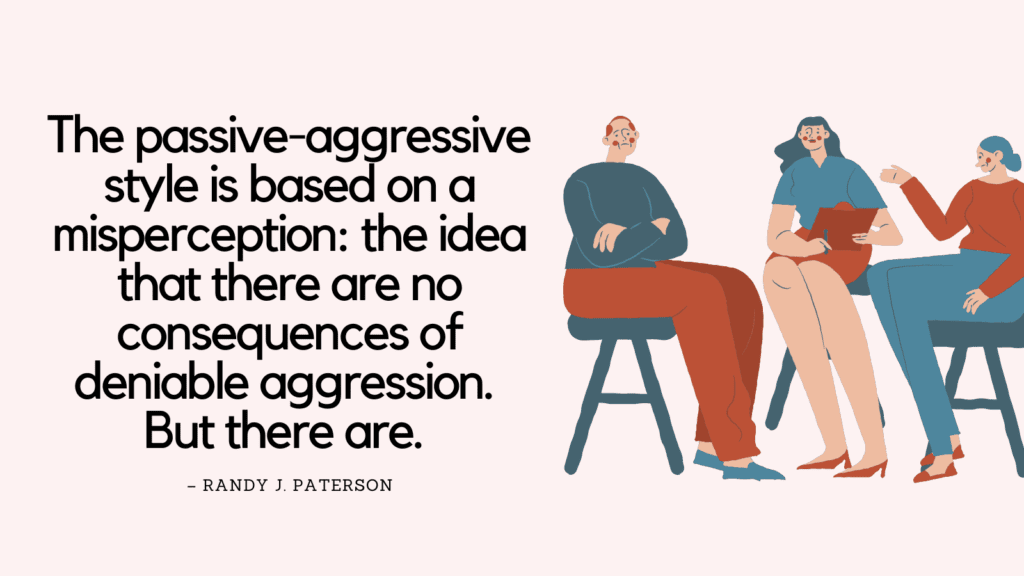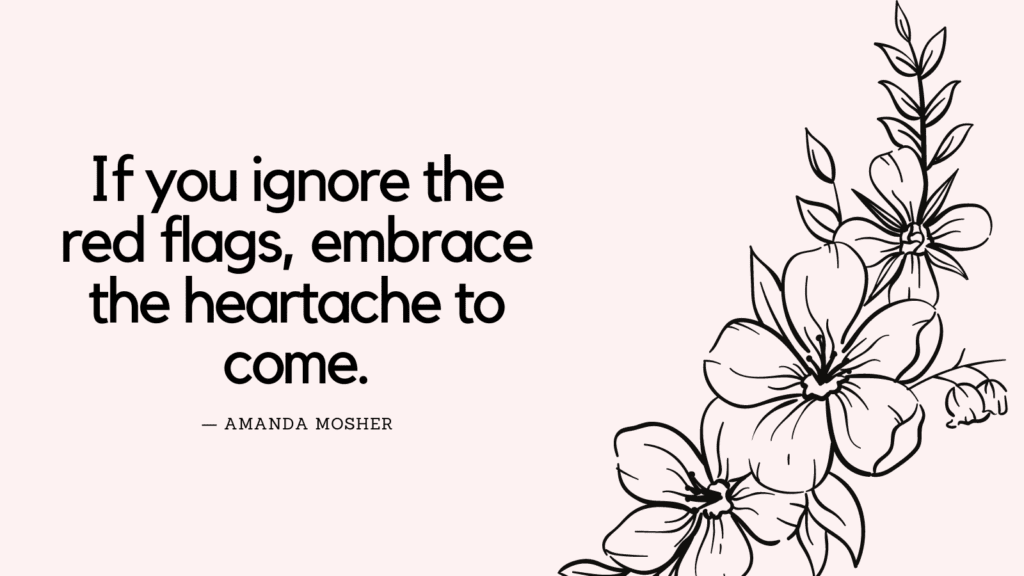This post contains some of the best passive aggressive quotes.
What Is Passive Aggressive Behavior?
Passive-aggressive behavior refers to a pattern of expressing negative feelings indirectly, often through subtle or covert actions.
It involves an avoidance of direct confrontation and a tendency to express anger, frustration, or resentment in passive ways.
Some common examples of passive-aggressive behavior include sarcasm, silent treatment, procrastination, playing the victim, and subtle acts of sabotage.
Passive-aggressive behavior can be detrimental to relationships as it often leads to confusion and miscommunication.
It creates an unhealthy dynamic where conflict is avoided or suppressed, making it difficult to address issues openly and find resolutions.
It can erode trust and lead to ongoing tension and resentment between individuals.
Passive Aggressive Quotes
1. “A charismatic person listens to understand because he/she is genuinely interested in what the speaker says. Instead of passively listening, he/she focuses on the speaker’s words.” – John Ward
2. “Acting and then denying responsibility is a passive-aggressive choice, not an assertive one.” – Randy J. Paterson
3. “Again, most people use all of the styles. You’re already assertive. And aggressive. And passive. And passive-aggressive. But you may be using one of the styles much more than the others. Which one is it?” – Randy J. Paterson
4. “As the name suggests, the passive-aggressive style combines elements of both the passive and the aggressive styles. The anger of the aggressive style and the fear of the passive style both have an influence. The anger makes you want to attack the other person, but the fear holds you back from doing it directly.” – Randy J. Paterson
5. “Based on our personality and history, we either fight back, retreat, become passive-aggressive, or simply stew over it and nurse our wounds before storing the resentments away like nuts for the winter.” – Hesha Abrams
Related: Do’s And Don’ts Of Effective Communication
6. “Be active and not passive when listening to others because it is through communication; you can tell if a person is doing alright or not. Some people listen passively (they hear the words but do not understand the statements); thus, they are unable to grasp what the speaker needs fully.” – John Ward
7. “Because the passive-aggressive strategy involves controlling the behavior of others, it ultimately reinforces our own sense of helplessness and anxiety.” – Randy J. Paterson
8. “Do not be passive-aggressive about it. As long as you are dealing with a sensible person and you are respectful with your request, the other person will discuss things with you in the proper manner.” – John Ward
9. “If passive-aggressive behavior has been a habit, you may tend to become indirect or sarcastic in confrontations. Strategies that will help you retain a candid, direct style will be the most critical to remember.” – Randy J. Paterson
10. “If you’ve often behaved passive-aggressively, they may wonder what it means when you speak openly and plainly. Are you enraged? Do you mean it? Are you being sarcastic? Is there a trick? Is this all just another manipulative strategy? Keep at it and they’ll learn.” – Randy J. Paterson
Related: How To Validate Someone’s Feelings Without Agreeing? (+Examples of Validating Statements)
11. “It sounds trite to say, “take a deep breath,” but it works. When you feel attacked, your natural inclination, stemming from the primeval neurological programming of the amygdala in your reptilian brain, is to defend yourself, either by being aggressive or passive-aggressive.” – Hesha Abrams
12. “Lots of distorted beliefs can cause us to behave in an unassertive manner. The next section lists some of these. Certain beliefs apply more to people who overuse the passive style, others to those who are too aggressive. Those who use the passive-aggressive style often hold a combination of both types of beliefs.” – Randy J. Paterson
13. “Openly assertive or aggressive behavior may have been punished in the past. There may also be a desire for rescue. If I behave helplessly enough, surely someone will come and help me.” – Randy J. Paterson
14. “People usually see through the manipulation more easily than the passive-aggressive person imagines.” – Randy J. Paterson
15. “The passive-aggressive strategy is to say yes and then fail to go along with the request anyway.” – Randy J. Paterson
16. “The passive-aggressive style involves a combination of attack and the avoidance of accountability—the fight and flight response.” – Randy J. Paterson
17. “The passive-aggressive style involves being both passive and aggressive at the same time. For example, being late and blaming traffic means that you simultaneously inconvenience the other person (aggressive) while avoiding responsibility for your actions (passive).” – Randy J. Paterson
Related: How To Become A Stronger Empath? Top 20 Actionable Empathy Exercises to Become More Empathetic
18. “The passive-aggressive style is based on a misperception: the idea that there are no consequences of deniable aggression. But there are. Eventually others begin to see us as unreliable, irresponsible, disorganized, or inconsiderate. Although they may never be able to point to specific examples, their general opinion of us will decline.” – Randy J. Paterson
19. “The passive-aggressive style usually looks passive but hides a secret aggressive motivation.” – Randy J. Paterson
20. “The person can communicate disapproval but doesn’t have to take responsibility. After all, they haven’t criticized you. “What do you mean? I didn’t say anything!” The key here is deniability. The person can deny feeling or thinking anything in particular. Meanwhile, they can make you feel anxious and insulted. This is a classic passive-aggressive strategy.” – Randy J. Paterson
21. “We may think our intentions were honorable. But did we feel a hint of satisfaction when things went wrong? Do we routinely do the same things, even though they always turn out awkwardly for someone else? Are we almost always late? Do we repeatedly take on projects that we should know we’ll never complete? If so, we may be using a passive-aggressive style without knowing it.” – Randy J. Paterson
22. “When we act passive-aggressively, we disguise our aggression so that we can avoid taking responsibility for it. Deniable hostility is the key.” – Randy J. Paterson
23. “You don’t know what others are dealing with and the pain they carry. They can express it aggressively, subtly, or passive-aggressively. When people feel disenfranchised, powerless, or discriminated against, their reality is based on their life experiences. Trying to change their perspective is pure folly. Trying to understand their perspective builds bridges.” – Hesha Abrams
Related: Top 19 Emotional Intelligence Activities (To Improve Low Emotional Intelligence)

How to Deal with Passive Aggressive Behavior?
Dealing with passive-aggressive behavior can be challenging, but there are several strategies you can employ to address this issue:
1. Recognize the behavior: Be aware of the signs of passive-aggressive behavior, such as indirect communication, sarcasm, subtle insults, and intentionally delaying tasks. Recognizing the behavior is the first step toward addressing it effectively.
2. Communicate openly: Engage in open and direct communication. Clearly express your concerns and how the passive-aggressive behavior affects you. Use “I” statements to convey your feelings, rather than accusing or blaming the person. This helps promote understanding and avoids escalating conflicts.
3. Encourage assertiveness: Encourage the person displaying passive-aggressive behavior to express their needs and concerns directly and assertively. Offer support and create a safe space for open communication. This approach may help reduce their reliance on passive-aggressive tactics.
4. Set clear boundaries: Establish and communicate clear boundaries regarding acceptable behavior. Make it known what behaviors are unacceptable to you and explain the consequences if those boundaries are repeatedly violated. Consistency is crucial in enforcing boundaries.
5. Practice empathy: Try to understand the underlying reasons behind the passive-aggressive behavior. While not excusing the behavior, recognizing that it may stem from fear, insecurity, or past experiences can help promote empathy and a more constructive approach to resolving conflicts.
Conclusion
Addressing passive-aggressive behavior requires effort from both parties involved. However, focusing on improving your own communication skills and setting healthy boundaries can contribute to a more positive and productive interaction.



